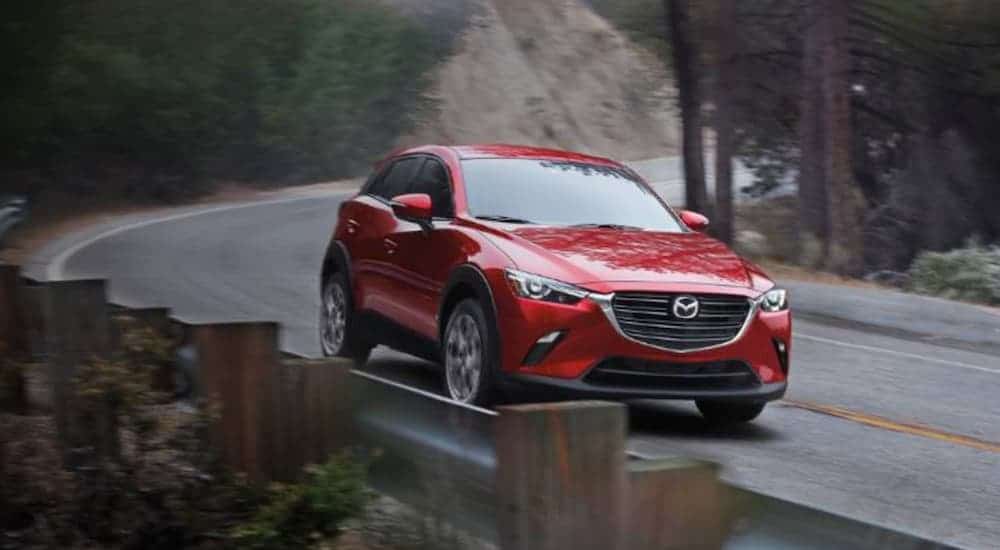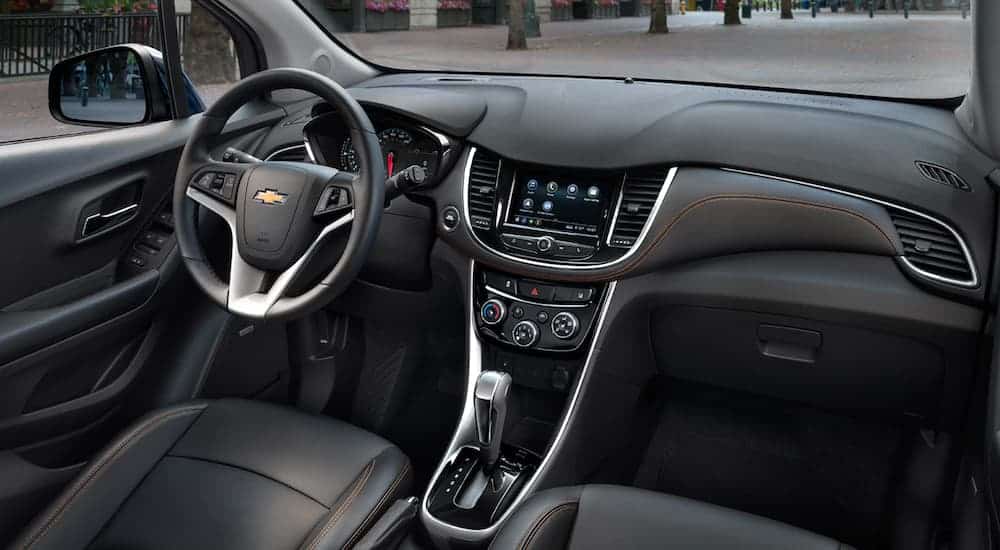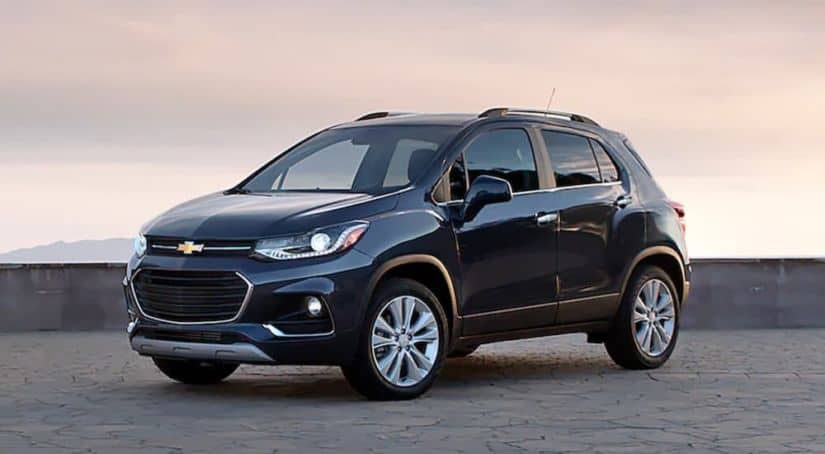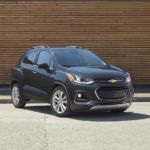Are you looking for the middle ground between a sedan and a full-size SUV? Compact SUVs are a great option because they offer more passenger and cargo space than a standard sedan without compromising fuel efficiency and affordability, both of which can be challenging in larger SUVs. This makes compact SUVs like the Chevy Trax and the Mazda CX-3 great for everything from daily commutes to epic adventures with family and friends. But how do the two models compare? Here’s a breakdown of the 2020 Chevy Trax vs 2020 Mazda CX-3.
Trims and Pricing
Both the 2020 Trax and the 2020 CX-3 are equally affordable, although the models offer a limited number of trims. The 2020 Trax starts at $21,300, with its top trim priced at $27,600. In comparison, the 2020 CX-3 starts at $20,640. Unlike the Trax, the CX-3 is only available in a single trim, but paint and other options can, of course, increase the price.
Marketed as sporty and refined, Mazda kept things simple with the 2020 CX-3 and offers the compact SUV in only the Sport trim with front-wheel drive or all-wheel drive, a 2.0-liter four-cylinder engine, and a six-speed automatic transmission with a manual shift mode. The CX-3 offers seating for five with 60/40 split fold-down rear seats and a long list of features that make it pleasant for both the driver and passengers. Three paint options will also add to the base price—Soul Red, Machine Grey Metallic, and Snowflake White Pearl.
Unlike the Mazda CX-3, the Trax gives drivers a few more options with three trims, all of which offer seating for five and come standard with a 1.4-liter turbo ECOTEC four-cylinder engine. The base LS trim starts at $21,300 and includes amenities like the Chevrolet Infotainment system with a 7-inch color touchscreen and rear vision camera. The middle LT trim starts at $23,200 and includes the standards from the LS model in addition to deluxe cloth seating, cruise control, remote vehicle start, and roof rack side rails. The top Premier trim starts at $27,600, and it includes Chevy’s driver confidence package, leather seating, and a power sunroof.
The Trax offers an additional package known as the Redline Edition, which is an upgrade available on the LT trim. The Redline Edition effectively serves as the sporty version of the Trax and features 18-inch black-finish aluminum wheels with red accent stripes, black mirror caps, and a black grille with black surround. The interior includes jet-black cloth and leather seating and jet-black interior accents.
Powertrain and Performance

In terms of powertrain and performance, these two compact SUVs are fairly equal but approach the problem differently. The 2020 Trax comes standard with a 1.4-liter turbocharged engine capable of producing 138 hp at 4,900 rpm and 148 lb-ft of torque at 1,850 rpm. The 2020 CX-3 comes with a larger 2.0-liter four-cylinder engine capable of producing 148 hp at 6,000 rpm and 146 lb-ft of torque at 2,800 rpm. Both SUVs pair their engines with six-speed automatic transmissions. While the CX-3 has higher top-end numbers for horsepower and torque, the turbocharger in the Trax means that its power is much more accessible and will be usable even in normal driving conditions without having to switch to manual mode to rev the engine up close to redline.
Passenger and Cargo Space
The Trax and the CX-3 go head-to-head for passenger space and cargo room with minimal difference between the models. Looking at the numbers, the Trax comes out on top thanks to its Cargo Management System that offers smart solutions to keep your gear organized with a maximum cargo length of 8 ft and a maximum cargo volume of 48.4 cu ft. This system includes a flat-folding front passenger seat and a flat-folding second row with a 60/40 split.
The CX-3 offers less cargo volume than the Trax with 42.7 cu ft with the second-row seats folded in the 60/40 split. Even when all the seats are in place, the Trax comes out ahead in cargo space with 18.7 cu ft against 17.8 cu ft for the CX-3. The CX-3 also offers less space for passengers with the sole exception of the front row legroom. Here’s how the interior dimensions and capacities compare for each model:
- Front headroom – 39.6 inches for the Trax vs 38.4 for the CX-3
- Rear headroom – 38.8 inches for the Trax vs 37.2 for the CX-3
- Front legroom – 40.8 inches for the Trax vs 41.7 for the CX-3
- Rear legroom – 35.7 inches for the Trax vs 35.0 for the CX-3
Technology

Chevy and Mazda don’t disappoint when it comes to the standard technology features on both the Trax and the CX-3, which makes the affordable price tags even more attractive. The Trax comes standard with a 7-inch color touchscreen, the Chevrolet Infotainment system, two USB ports with an auxiliary input jack, and Apple CarPlay and Android Auto compatibility. The Trax LT and Premier trims feature an infotainment upgrade with a seven-speaker Bose premium sound system with a subwoofer.
Like the Trax, the CX-3 also features a 7-inch full-color touchscreen display, and the Mazda Connect Infotainment System also offers Apple CarPlay and Android Auto integration. However, the CX-3 is only available with a basic six-speaker audio system. While the CX-3 compares well with the base trim of the Chevy Trax, its infotainment technology falls short of what is available in the higher trims of the Chevy.
Safety
Safety is also a top priority for Chevy and Mazda, which means that the Trax and CX-3 come with plenty of safety features beginning with standard airbags and three-point seatbelts. Both models also come standard with a rearview camera that makes driving in reverse easier, and a tire pressure monitoring system that alerts drivers of low tire pressure. From there, the safety features differ slightly due to Chevy’s three trims that offer enhanced safety features on the LT and Premier models.
The Trax LT offers the Driver Confidence Package, which includes Side Blind Zone Alert, Rear Cross-Traffic Alert, and Rear Park Assist, while the Premier trim comes standard with those same features. The Premier model also features Forward Collision Alert and Lane Departure Warning. This makes these technologies available if you want them, but it also means that you do not have to pay for them if you do not want them.
Because it only has a single trim, the Mazda CX-3 only has a single configuration when it comes to driver assistance technologies. This standard package includes Blind Spot Monitoring with Rear Cross Traffic Alert, Smart Brake Support, and Radar Cruise Control. But the CX-3 does not include any park assist technology beyond the rearview camera.
Making Your Choice
When it comes to choosing between the 2020 Chevy Trax and the 2020 Mazda CX-3, it isn’t an easy decision since the compact SUVs are similar in terms of performance, passenger and cargo room, technology, and safety. For drivers looking for more trim and upgrade options, the Trax certainly wins the race with its three trims compared to the single package of the CX-3. The Trax also offers more cargo and passenger room and an engine with a more usable powerband. While none of the differences are huge, overall, the scales do tilt in favor of the 2020 Chevy Trax.



